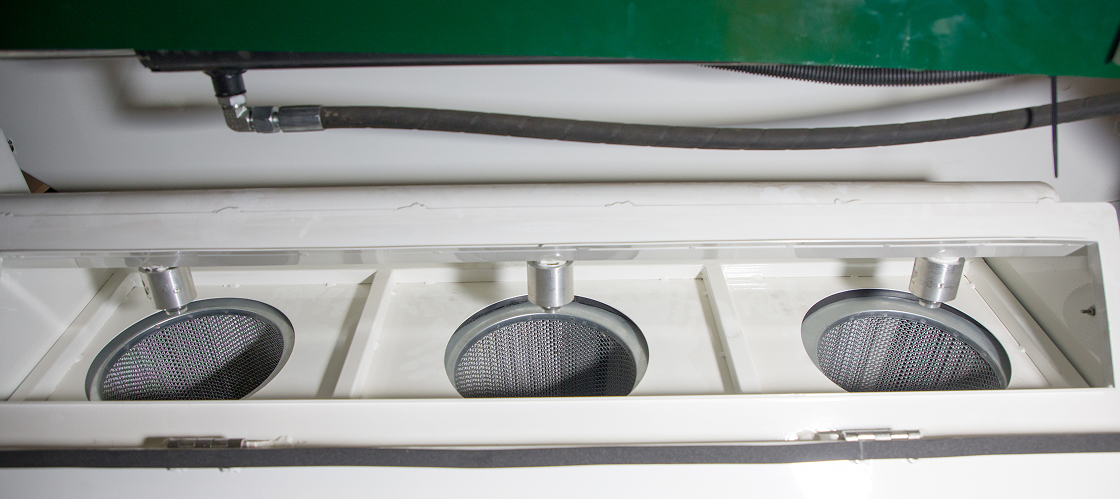Jatayu Super filtre-cleaning with pulse jets
Introduction
When a vacuum-based litter picker operates, it sucks in air mixed with dust, debris, and litter. To ensure that only clean air exits the system and to prevent damage to the machine, the machine has filter cartridges to trap the dust. Over time, these filters accumulate dust, which clogs the airflow and reduces suction efficiency.
If filters are neglected, suction performance drops, leading to higher engine load, overheating risks, and even potential machine shutdowns, especially in heavy dust zones. Cleaning the filters is essential to keep the machine performing effectively. The problem itself is universal, but how well a machine deals with it defines its efficiency, uptime, and usability.
Filter cleaning in litter pickers
1. Manual filter cleaning
In machines without automated cleaning, the operator must stop work, open the filter chamber, and physically remove the filters. These are then shaken, tapped, or blown out using compressed air to remove accumulated dust. Some operators may also wash the filters and allow them to dry before reuse. This entire process is typically done away from the worksite, often in a maintenance area.
Challenges:
Manual cleaning is time-consuming and disrupts workflow, especially during long or dusty shifts. It is labor- intensive, exposes the operator to dust, and often yields inconsistent results depending on the thoroughness of cleaning. If not done properly or frequently enough, dust buildup restricts airflow, leading to a noticeable drop in suction performance and reduced litter collection efficiency. Repeated handling also risks damaging filter media, shortening the filter’s lifespan.
2. Mechanical vibration filter cleaning
In this system, the machine is equipped with vibration motors or actuators attached to the filter housing. At set intervals, or when triggered manually, the system activates, causing the filters to vibrate or shake. This helps dislodge loose dust particles from the surface of the filter media. The released dust is either collected in a bin or resettles into the airflow path.
Challenges:
While more convenient than manual cleaning, mechanical vibration is often less effective at removing embedded fine dust, especially in dense or pleated filter materials. As a result, residual dust continues to block airflow, leading to gradual performance loss. Repeated vibration can also weaken or damage the filter structure over time, reducing its durability and requiring more frequent replacements.
Pulse jet cleaning in Jatayu Super

To overcome the limitations of both manual and mechanical systems, the Jatayu Super introduces a fully automatic, air-driven pulse jet cleaning mechanism. A built-in, cartridge filter cleaning system that uses pressurized air to dislodge dust from the PM10-rated pleated filters without requiring manual intervention.
- The system is powered by an onboard air compressor, connected to pulse jetting heads that target the filter cartridges.
- The entire cleaning process can also be easily started by the operator with the press of a button, especially helpful when filters get heavily choked mid-shift.
- At predetermined intervals (roughly every 3 minutes during a cycle), the system releases controlled pulses of air that shake off fine dust accumulated on the filter surfaces.
- A full cleaning session can be carried out whenever needed and takes around 15 minutes. This is especially useful on dusty routes, where filters can clog mid-shift.
There’s no need to return to the service bay; the cleaning can be done right where the machine is parked, restoring suction performance without interrupting the shift.
Benefits of Jatayu Super pulse jet cleaning
No Manual Labor or Dust Exposure
Manual cleaning exposes operators to dust and demands physical effort. Jatayu Super’s pulse jet system eliminates this burden-the cleaning is fully automated, activated with just the press of a button, keeping the operator clean, safe, and focused on the job.
On-Demand Cleaning Without Downtime
Manual cleaning exposes operators to dust and demands physical effort. Jatayu Super’s pulse jet system eliminates this burden-the cleaning is fully automated, activated with just the press of a button, keeping the operator clean, safe, and focused on the job.Unlike manual systems that require filter removal and travel to a service bay, pulse jet cleaning can be done anytime during a shift, right where the machine is parked. This means no disruption to operations—a quick cleaning session fits neatly into an operator’s short break.
Effective Deep Cleaning vs. Surface-Level Vibration
Unlike manual systems that require filter removal and travel to a service bay, pulse jet cleaning can be done anytime during a shift, right where the machine is parked. This means no disruption to operations—a quick cleaning session fits neatly into an operator’s short break.
Protects Filter Life
Whereas constant shaking in mechanical systems may wear out or damage filter media, pulse jetting is a non-contact process. It maintains the structural integrity of the cartridges, extends filter lifespan, reduces maintenance costs, and increases ROI.
Maintains Consistent Suction
Neglected or poorly cleaned filters reduce airflow and vacuum strength. Pulse jetting prevents filter choking, ensuring consistent suction throughout the shift, even in high-dust environments.
Pulse jetting in the Jatayu Super is an advanced, pressurized air-based filter cleaning system that enables automatic, on-the-go cleaning of filter cartridges. It enhances machine uptime, reduces labor, and improves cleaning effectiveness, making it a
standout feature in high-performance litter vacuum machines and significantly enhancing total return on investment (ROI).
